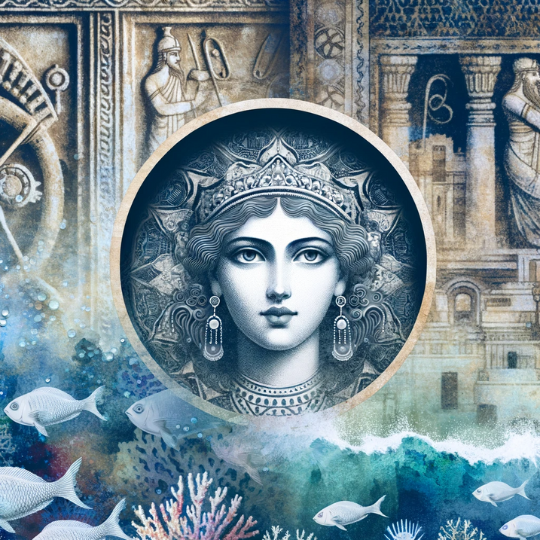Atargatis, known as Derceto to the Greeks, is a figure shrouded in the mystique of ancient mythology and revered as one of the earliest mermaid deities. This revered figure from the annals of Classical antiquity offers a fascinating glimpse into the intersection of facts about the ocean and facts about mermaids, blending history, myth, and the wonders of marine lore.
The Goddess of Fertility and Protection
Primarily celebrated as a fertility goddess, Atargatis was also the baalat or 'mistress' of her people, responsible for their protection and well-being. Her chief sanctuary was located in Hierapolis, now modern-day Manbij, northeast of Aleppo, Syria. Michael Rostovtzeff, a historian, honored her as "the great mistress of the North Syrian lands." Her consort was Hadad, and she was venerated for her association with doves, symbolizing love, and fish, representing fertility and life of the waters.
Transformation into a Mermaid
Atargatis is often described as a mermaid-goddess, a unique blend of human and aquatic form that captures the essence of her divine nature. This depiction likely originated from her identification with a fish-bodied goddess at Ashkelon. The myth that best illustrates her transformation into a mermaid involves a tragic tale of love and sacrifice. According to the legend, Atargatis, in a bout of despair over a lost love, threw herself into a lake. Instead of perishing, she transformed into a fish. However, the waters could not conceal her divine beauty, and she remained half-human, with the face of a woman.
Roots in Ancient Deities
Atargatis is a continuation of various Bronze Age goddesses. The Ugarit cuneiform tablets reveal connections to Canaanite goddesses, including ʾAṯirat, the 'Lady of the Sea,' and Anat, a war goddess. These deities shared many traits and may have been worshipped together or separately over 1500 years of cultural history.
The Name and Its Significance
The original Aramaic name of Atargatis was ʿAttarʿattā, a combination of 'ʿAttar' meaning goddess and 'ʿAttā', the Aramaic variant of the name of the goddess Anat. This etymology underscores her significance in ancient Syrian and broader Mesopotamian religious traditions.
Atargatis and Hadad: Divine Couple
Atargatis frequently appears alongside Hadad, and together they were seen as the protecting deities of their community. Atargatis, often depicted wearing a mural crown, was considered the ancestor of the royal house and the founder of social and religious life.
Derceto's Mermaid Form and the Legend of Semiramis
The name Derceto was attributed to Atargatis in her mermaid form, specifically revered at Ashkelon, Syria. The myth surrounding Derceto involves a tragic love story with a youth named Simios (or Ichthys, 'fish'), resulting in the birth of a daughter. Overcome with shame, Derceto flung herself into a lake, transforming into a half-fish, half-human entity, while her daughter was left in the desert, only to be raised by doves and grow up to become the legendary Assyrian queen Semiramis.
Astrological and Cultural Significance
The legends surrounding Atargatis are numerous and often of an astrological character. They provide insight into ancient Syrian culture, including dove worship and abstinence from fish, tied to the story of Atargatis' transformation and her divine connections.
This rich tapestry of mythology surrounding Atargatis offers a captivating journey into the ancient world, where facts about mermaids intertwine with the broader narrative of oceanic deities. Her story is not just a tale from the past but a reminder of the enduring fascination humanity holds for the mysteries of the sea and the mythical beings believed to inhabit its depths.





